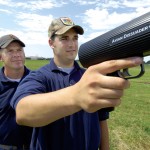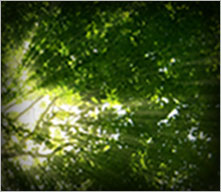AD in the news
WCTV news Tallahassee Airport Bird Control
“We purchased a device called the Avian Dissuader. Birds just don’t like it, and when they see it they just don’t want to be around it,” says Jim Durwin, Assistant Superintendent of Operations at Tallahassee Regional Airport.
Tinker AFB news
Birds up to one half mile away will flee an area when the Avian Dissuader’s red laser beam is flashed their way. United States Department of Agriculture and Wildlife Services biologist Clarke Baker, back, and wildlife specialist Matt Gage use the device in their non-lethal arsenal to keep birds away from Tinker, protecting aircraft from bird strikes. (Air Force photo by Margo Wright)
Golf Course Management magazine
Nick McCraw, superintendent at Balmoral Woods Country Club near Chicago and an 11-year GCSAA member, has been happy with the results of his Avian Dissuader laser. Last spring, he reduced the flock on his course from 150 geese to 20 after using the laser every day for two weeks. “The laser scares the heck out of the geese,” McCraw says. “They were bumping into each other trying to get away.”
McCraw likes the Avian Dissuader because it’s easy to use, he can haze geese from two or three fairways away, and replacement batteries (9-volt) are inexpensive and readily available. “The laser is not harmful to the geese,” McCraw says. “I like that.
Bird/Aircraft Strike Hazard Evaluation at U.S. Naval Air Stations, CA
Under Interagency Agreements with the U.S. Navy, NWRC biologists from Fort Collins, CO, are evaluating bird/aircraft strike hazard problems at Point Mugu and San Clemente Naval Air Stations, CA, and assessing habitat modification management techniques. At both naval air stations, researchers are using a geographic information system (GIS) to record habitat types adjacent to runways and the numbers, species, locations, altitudes and local movements of birds on and near airfields. NWRC researchers also evaluated the use of the Avian Dissuader (a low-power laser hazing device) for dispersing birds at Point Mugu Naval Air Station. For three days, lasers were used to haze waterfowl, turkey vultures, shorebirds, herons, and red-tailed hawks at night. After 2000 hrs (10 PM), the laser was used successfully to haze all waterfowl species except for American coots.
St. Louis – Federal employees shoo crows away with lasers
(KMOV news) — Every winter, thousands of crows move in and roost on high rise buildings at the Washington University medical center. The birds leave behind a dirty mess that can also be a health hazard. This year, the federal government is joining the fight against the birds. Monday night, they waged the first nonviolent battle.
As sundown approaches, they roll in by the thousands. In a nightly invasion, the crows first take up positions to the east toward Downtown, and then waves of crows claim the rooftops of the high-rise buildings of Washington University Medical Center.
“Birds just have a tendency to go where they’re comfortable and they keep going back year after year after year,” says Rosemary Heinen of the USDA Wildlife Services.
It is believed that the heat put out by the buildings attracts this annual winter roost, but it’s certain that the invading force are ungrateful visitors, leaving behind a dirty and unhealthy mess.
“The idea is just to keep as many birds away as possible because if you get a handful in, all of them will come in,” Heinen says.
This year, the medical center has gone high tech bringing in laser equipped federal troops.
“It does not hurt the birds. It does not hurt their eyes or anything like that. It’s just a mild irritant,” Heinen says.
Three Wildlife Service employees from the U.S. Agriculture Department have been contracted to run the birds off with lasers designed for this. The lasers seem to work, after a while, these birds won’t even try to get back in if they’re lasered enough.




